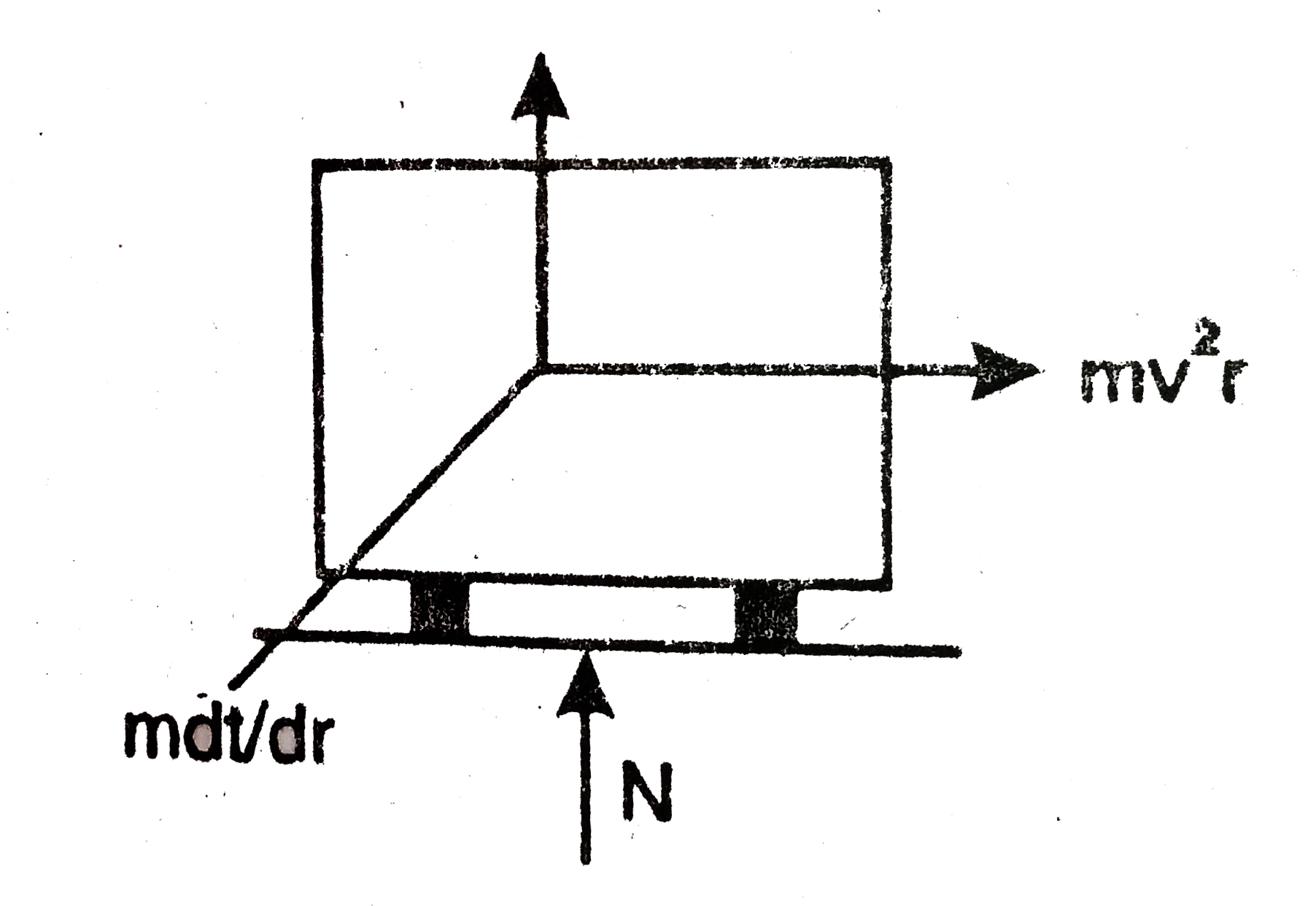A car starts rest, on a horizontal circular road of radius R, the tangential acceleration of the car is a. The friction coefficient between the road and the tyre is μ Find the speed at which car will skid and also find the distance after travelling it skids.
The correct Answer is:A, B, D
Since the motion is non uniform, the acceleration has both radial and tangential components.
a=v2r
at=dvdt=a
Resultnt magnitude = √(v2r)2+a2
Now,mN=m√(v2r)2+a2
→μmg=m√(v2r)2+a2
→μ2g2=v4r2+a2

→v4r2=(μ2g2−a2)
→v4=(μ2g2−a2)r2
→v=[(m2g2−a2)r2])14)
Topper's Solved these Questions
- CIRCULAR MOTIONBOOK - HC VERMACHAPTER - CIRCULAR MOTIONEXERCISE - Objective 2
7 Videos
- CENTRE OF MASS, LINEAR MOMENTUM, COLLISIONBOOK - HC VERMACHAPTER - CENTRE OF MASS, LINEAR MOMENTUM, COLLISIONEXERCISE - Exercises
64 Videos
- FLUID MECHANICSBOOK - HC VERMACHAPTER - FLUID MECHANICSEXERCISE - Exercises
35 Videos
Similar Questions
A car starts from rest in a circular flat road of radius R with an acceleration a. The friction coefficient between the road and the tyred is μ Find the distance car will travel before is start skidding.
View SolutionA car goes on a horizontal circular road of radius R. The speed of car is increasing at constant rate a m/s2. If the friction coefficient between the road and the tyre is μ, then the limiting speed of car is
View Solution
Knowledge Check
A body moves on a horizontal circular road of radius of r, with a tangential acceleration aT. Coefficient of friction between the body and road surface is μ. It begin to slip when it's speed is v, then :
Av2=μrgBug=v2r+aTCμ2g2=v4r2+a2TDThe force of friction makes an angle tan−1(v2aT×r) with direction of motion at point of slipping.A car starts moving from rest on a horizontal circular road of radius of curvature R at . The speed of the car is increasing at a constant rate a. The coefficient of friction between the road and the tyres of the car is The car starts slipping at timet=t0 . Then t0 is equal to:
A.4√μ2g2R2aB.4√R2(μ2g2−a2)aC.4√R2(a2−μ2g2)aD.4√R2(μ2g2+a2)aA car moves along a horizontal circular road of radius r with constant speed v. The coefficient of friction between the wheels and the road is μ. Which of the following statement is not true ?
AThe car slips if v>√μrgBThe car slips if μ<(v2/rg)CThe car slips if μ>(v2/rg)DThe car slips at a lower speed if it moves with some tangential acceleration, then if it moves at constant speed
A car starts from rest on a horizontal circular road of radius 190 m and gains speed at a uniform rate 1⋅2m/s2 . The coefficient of static between the road and the tyres is 0⋅37 . Calculate the distance travelled by the car before it begins to skid.
View SolutionA car is moving on a horizontal circular road of radius 0.1 km with constant speed. If coefficient of friction between tyres of car and road is 0.4, then speed of car may be (g=10m/s2)
View SolutionA car is travelling on a circular banked road. The centripetal accelerations of a car is provided by
View SolutionA car starts from rest to cover a distance s. the coefficient of friction between the road and the tyres is μ. The minimum time in which the car can cover the distance is proportional to
View SolutionA car is negotiating a curved road of radius R. The road is banked at an angle θ. The coefficient of friction between the tyres of the car and the road is μs. The maximum safe velocity on this road is
View Solution